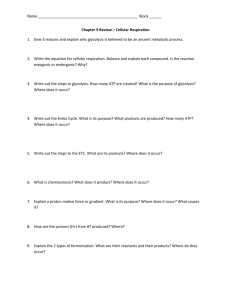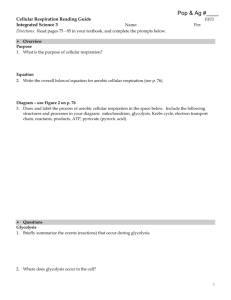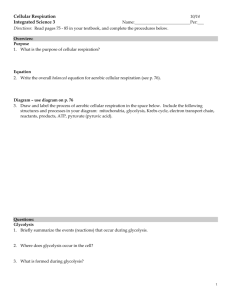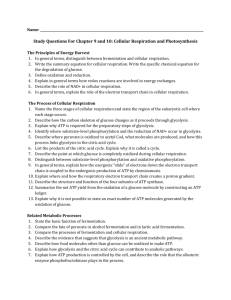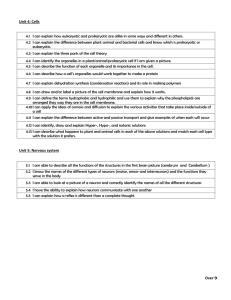Metabolism – Chapters 8, 9, and 10
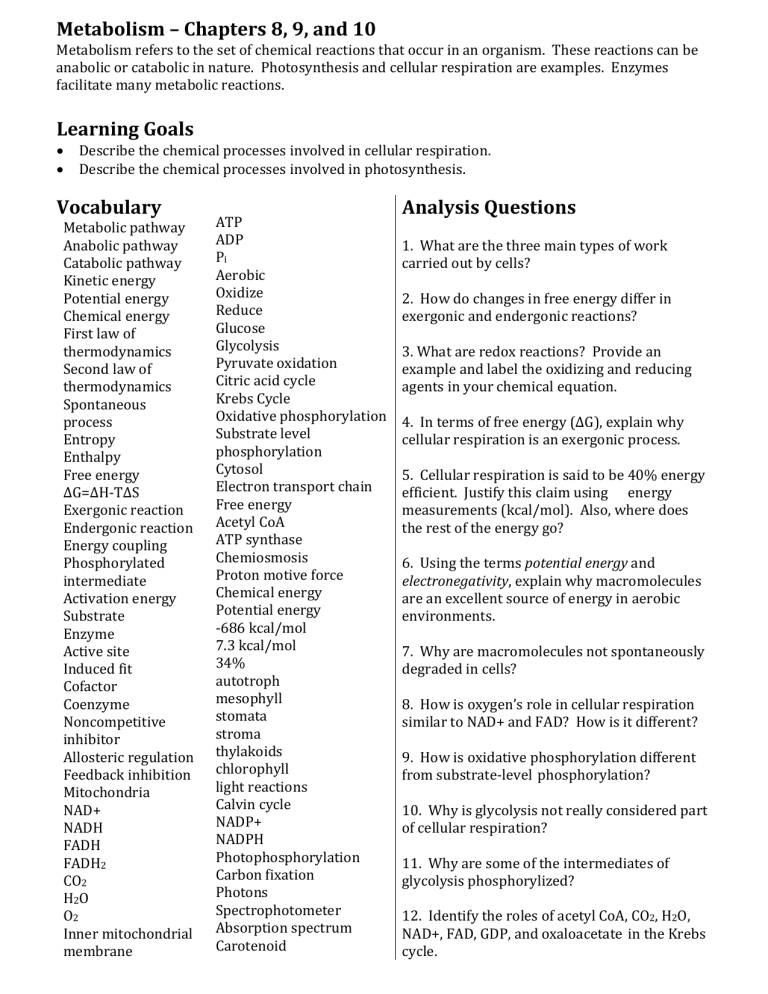
Metabolism – Chapters 8, 9, and 10
Metabolism refers to the set of chemical reactions that occur in an organism. These reactions can be anabolic or catabolic in nature. Photosynthesis and cellular respiration are examples. Enzymes facilitate many metabolic reactions.
Learning Goals
Describe the chemical processes involved in cellular respiration.
Describe the chemical processes involved in photosynthesis.
Vocabulary
Metabolic pathway
Anabolic pathway
Analysis Questions
1. What are the three main types of work
Catabolic pathway
Kinetic energy
Potential energy
Chemical energy
First law of thermodynamics
Second law of thermodynamics
P i
Aerobic
Oxidize
Reduce
Glucose
Glycolysis
Pyruvate oxidation
Citric acid cycle
Krebs Cycle
Spontaneous process
Entropy
Enthalpy
Free energy
ΔG=ΔH-TΔS
Exergonic reaction
Endergonic reaction
Energy coupling
Oxidative phosphorylation
Substrate level phosphorylation
Cytosol
Electron transport chain
Free energy
Acetyl CoA
ATP synthase
Chemiosmosis carried out by cells?
2. How do changes in free energy differ in exergonic and endergonic reactions?
3. What are redox reactions? Provide an example and label the oxidizing and reducing agents in your chemical equation.
4. In terms of free energy (∆G), explain why cellular respiration is an exergonic process.
5. Cellular respiration is said to be 40% energy efficient. Justify this claim using energy measurements (kcal/mol). Also, where does the rest of the energy go?
Phosphorylated intermediate
Activation energy
Substrate
Enzyme
Active site
Induced fit
Cofactor
Coenzyme
Noncompetitive
Proton motive force
Chemical energy
Potential energy
-686 kcal/mol
7.3 kcal/mol
34% autotroph mesophyll stomata stroma
6. Using the terms potential energy and
electronegativity, explain why macromolecules are an excellent source of energy in aerobic environments.
7. Why are macromolecules not spontaneously degraded in cells?
8. How is oxygen’s role in cellular respiration similar to NAD+ and FAD? How is it different? inhibitor
Allosteric regulation
Feedback inhibition
Mitochondria
NAD+
NADH
FADH
FADH
2
CO
2
H
2
O
O
2
Inner mitochondrial membrane thylakoids chlorophyll light reactions
Calvin cycle
NADP+
NADPH
Photophosphorylation
Carbon fixation
Photons
Spectrophotometer
Absorption spectrum
Carotenoid
9. How is oxidative phosphorylation different from substrate-level phosphorylation?
10. Why is glycolysis not really considered part of cellular respiration?
11. Why are some of the intermediates of glycolysis phosphorylized?
12. Identify the roles of acetyl CoA, CO
2
, H
2
O,
NAD+, FAD, GDP, and oxaloacetate in the Krebs cycle.
Photosystem II
Photosystem I
Linear electron flow
Cyclic electron flow
G3P
RuBP
Photorespiration
C3
C4
Bundle sheath cells
PEP carboxylase
CAM
13. Describe how the proton-motive force drives ATP synthesis.
14. Explain how the role of pyruvate changes in aerobic and anaerobic conditions.
15. Are proteins and lipids used as fuel for cellular respiration in the same way as carbohydrates? Explain.
16. How is phosphofructokinase used to regulate ATP synthesis rates in cells?
17. Are the molecules involved in glycolysis and the Krebs cycle used only for catabolism?
Explain.
18. What are the light and dark reactions?
19. What is the difference between C3, C4, and
CAM?
20. What are absorption spectra and action spectra?
21. What are the differences between photosystem I and II?
22. What is the difference between cyclic and noncyclic electron flow?
23. What is the difference between cyclic and noncyclic photophosphorylation?
24. Describe chemiosmosis in chloroplasts. Is it the same as in mitochondria?
25. Why are carotenoids important to plants?
26. What is the role of RuBP in photosynthesis?
G3P?
27. Describe the relationship between photosynthesis and cellular respiration.
